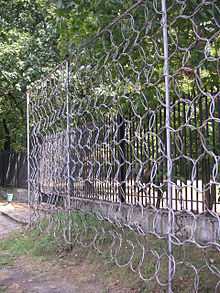Indicator net

Constructed using light steel nets, indicator nets were often anchored at various depths to the sea bed around Allied naval bases during World War II. They were intended to entangle U-boat traffic of the enemy, even though the submarines often managed to disentangle themselves and escape before being blown up by depth charges.
Predominantly deployed by the Royal Navy as a means of discouraging enemy submarines from entering Allied waters, indicator nets were used extensively during the war. Individual nets were sometimes as much as 100 meters in length.
Instead of being used as the sole anti-submarine measure, indicator nets were often mixed with extensive minefields and patrolling warships. Sometimes mines were attached directly to the nets, thus reducing submarine survival chances.
After a submarine became entangled in the net, a marker buoy attached to the net drifted along the water's surface indicating an enemy below. The first example of indicator nets causing the destruction of a U-boat occurred at Dover when the U-8 became entangled on March 4, 1915.
| Wikimedia Commons has media related to Anti Sub Warfare. |